
The Royal Air Force Regiment is part of the Royal Air Force and functions as a specialist corps. Founded by Royal Warrant in 1942, the Corps carries out basic security tasks relating to the [protection of] delivery of air power.

Royal Air Force Dishforth or more simply RAF Dishforth is a former Royal Air Force station near Thirsk in North Yorkshire, England. Opened in 1936, the base was used as a bomber airfield during the Second World War with both British and Canadian squadrons flying missions from the airfield. After the war, the base was used by various squadrons and training units before being disposed of in 1992 and handed over to the Army Air Corps.

The King's Colour Squadron, formerly the Queen's Colour Squadron, is the unit of the Royal Air Force charged with the safe-keeping of the King's Colour for the Royal Air Force in the United Kingdom. Since its formation, it has been formed exclusively by Officers and Gunners of No. 63 Squadron RAF Regiment.
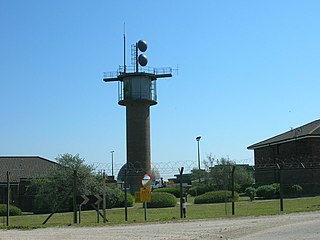
RemoteRadarHeadStaxton Wold or RRH Staxton Wold is an air defence radar station operated by the Royal Air Force, located near Scarborough in North Yorkshire, England. As it has been a radar site continuously since 1939, it has a claim to be the oldest working radar station in the world. the base has undergone many upgrades of different radar systems and sits on the top of Staxton Wold at a height of 590 feet (180 m) above sea level.

Royal Air Force Finningley or more simply RAF Finningley is a former Royal Flying Corps and Royal Air Force station at Finningley, in the Metropolitan Borough of Doncaster, South Yorkshire, England. The station straddled the historic county boundaries of both Nottinghamshire and the West Riding of Yorkshire.
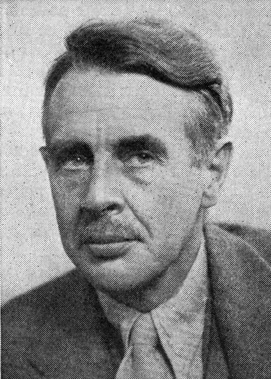
Leo Walmsley was an English writer. Walmsley was born in Shipley, West Riding of Yorkshire, but brought up in Robin Hood's Bay in the North Riding. Noted for his fictional Bramblewick series, based on Robin Hood's Bay, he fought in the Royal Flying Corps, later the Royal Air Force, in the First World War, being awarded the Military Cross.

Giggleswick School is a public school in Giggleswick, near Settle, North Yorkshire, England.

Princess Mary's Royal Air Force Nursing Service (PMRAFNS) is the nursing branch of the British Royal Air Force.
Air Chief Marshal Sir Ronald Andrew Fellowes Wilson,, often known as Sir Andrew Wilson and sometimes known informally as Sir Sandy Wilson, is a retired senior Royal Air Force officer.

The Women's Royal Air Force (WRAF) was the women's branch of the Royal Air Force. It existed in two separate incarnations: the Women's Royal Air Force from 1918 to 1920 and the Women's Royal Air Force from 1949 to 1994.

Royal Air Force Habbaniya, more commonly known as RAF Habbaniya, , was a Royal Air Force station at Habbaniyah, about 55 miles (89 km) west of Baghdad in modern-day Iraq, on the banks of the Euphrates near Lake Habbaniyah. It was developed from 1934, and was operational from October 1936 until 31 May 1959 when the RAF finally withdrew after the July 1958 Revolution made the British military presence no longer welcome. It was the scene of fierce fighting in May 1941 when it was besieged by the Iraqi Military following the 1941 Iraqi coup d'état.

Royal Air Force Detling, or more simply RAF Detling, is a former Royal Air Force station situated 600 feet (180 m) above sea level, located near Detling, a village about 4 miles (6.4 km) miles north-east of Maidstone, Kent.
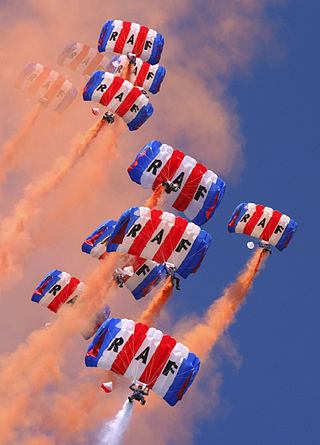
The RAF Falcons are a British military parachute display team. They perform their colourful aerial display at venues nationwide and are renowned for their 11-person non-contact canopy stack display routine, which reaches speeds of up to 120 miles per hour (190 km/h).
Air Chief Marshal Sir David George Parry-Evans, was a senior Royal Air Force commander.
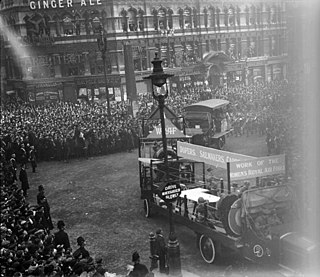
The Women's Royal Air Force (WRAF) was the women's branch of the Royal Air Force, existing from 1 April 1918 until 1 April 1920, when it was disbanded. Its original intent was to provide female mechanics in order to free up men for front line service in World War I. However, the organisation saw high enrolment, with women also serving in a number of other non-combatant roles, including drivers, caterers, clerks and tailors, as well as filling other wartime needs.

Bramham Moor Aerodrome,, was a First World War era military airfield near to the village of Bramham, West Yorkshire, England. Initially a Royal Flying Corps site, on the formation of the RAF, its name was officially changed to RAF Tadcaster, however, the unit was still referred to as Bramham, or Bramham Moor, even in official documents. The base was used between March 1916 and December 1919 by active aircraft squadrons, but was not closed down until April 1920. Bramham was originally used as a Home Defence station, due to the threat of Zeppelin attacks, but later, it was used primarily for preparing aircrew for front line operations. It did not see re-use as an airfield during the Second World War, however, vehicles were parked on the grassed runway areas to deter glider landings during the threat of invasion.

Operation Highbrow was a British Ministry of Defence (MoD) operation to evacuate civilians from Beirut as a result of the escalating 2006 Lebanon War. Initially, helicopters started ferrying the most vulnerable to Cyprus with several Royal Navy ships later transporting evacuees across the Mediterranean Sea to Cyprus. The operation involved Royal Navy surface ships and helicopters, with Royal Air Force helicopters also providing support and transit. The operation was described as being the largest evacuation that Britain was involved in since Dunkirk.
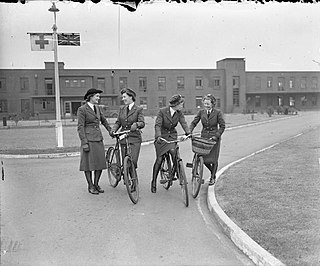
RAF Hospital Ely, was a Royal Air Force staffed military hospital in Ely, Cambridgeshire, England. The hospital opened in 1940, and was one of a handful of Second World War era RAF hospitals that were kept open post Second World War, remaining a military asset until 1992, although it also treated non-service patients, usually those who lived locally. On closure, the hospital became a civilian hospital under the NHS. Although not located on an established RAF Base, RAFH Ely was located within 50 miles (80 km) of forty RAF bases in the Second World War.

No. 2 School of Technical Training RAF is a current training unit within the Royal Air Force. The school formed at Cranwell in 1920, and was later disbanded before being reformed at a new base, RAF Cosford, in 1938. It was closed in 1994, but in July 2023, it was reactivated and has become part of the training environment at RAF Cosford.





















